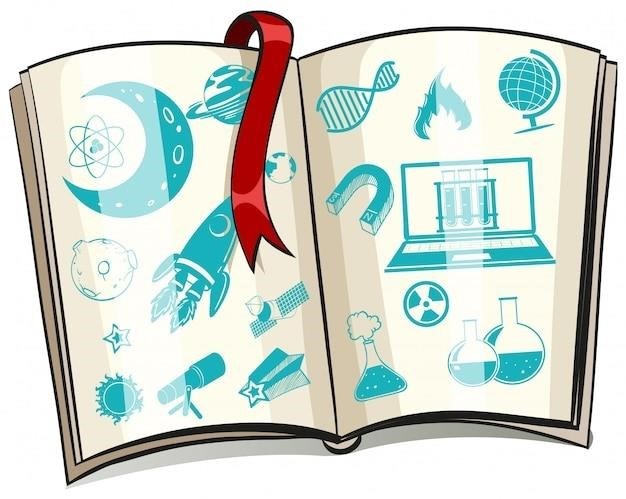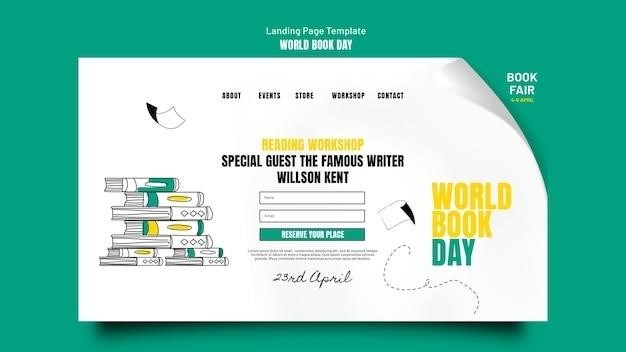The Knowledge Book⁚ A Guide to Understanding the World
This comprehensive guide explores the nature, structure, and application of knowledge, providing readers with a framework for understanding the world around them․
Introduction⁚ The Power of Knowledge
Knowledge is the foundation of human progress․ It empowers us to understand the world around us, solve complex problems, and create a better future․ From the earliest civilizations to the modern age, knowledge has been the driving force behind innovation, discovery, and societal advancement․
The pursuit of knowledge is a journey of lifelong learning, a quest to expand our understanding and enhance our capabilities․ It is through knowledge that we gain insights into the natural world, develop critical thinking skills, and cultivate empathy and compassion․ By embracing the power of knowledge, we can unlock our potential and contribute meaningfully to society․
The Structure of Knowledge
Knowledge is not a monolithic entity; it exists in various forms and structures․ Understanding these structures helps us navigate the vast landscape of information and make sense of the world․ One way to categorize knowledge is by its disciplinary focus․ Disciplinary knowledge is organized within specific fields of study, such as science, history, or literature․ Each discipline has its own methods, theories, and principles, providing a framework for understanding its specific domain․
Interdisciplinary knowledge, on the other hand, emerges from the intersection of different disciplines․ It involves drawing insights from multiple fields to address complex problems or develop new perspectives․ Practical knowledge, often acquired through experience and hands-on application, is another crucial aspect․ It encompasses the skills, techniques, and know-how necessary to solve problems and accomplish tasks in real-world settings․
2․1․ Disciplinary Knowledge
Disciplinary knowledge is characterized by its focus on a specific area of study, each with its unique set of methods, theories, and principles․ For instance, in the field of physics, knowledge is structured around the laws of motion, gravity, and energy․ Historians, on the other hand, rely on primary sources, historical analysis, and critical thinking to understand past events․ This structured approach allows for a deep understanding of a particular subject matter, fostering expertise and specialized knowledge within a specific domain․ Disciplinary knowledge is often acquired through formal education, research, and professional training․
It provides a foundation for understanding the world, but it also encourages specialization, leading to a rich tapestry of diverse knowledge across various fields․
2․2․ Interdisciplinary Knowledge
Interdisciplinary knowledge emerges from the synthesis of insights and perspectives from multiple disciplines․ It transcends the boundaries of individual fields to explore complex issues that require a holistic approach․ For example, understanding climate change requires insights from physics, biology, economics, and social sciences․ This interconnected approach fosters a more comprehensive understanding of multifaceted problems, encouraging collaboration and cross-fertilization of ideas․
Interdisciplinary knowledge is often fostered in research collaborations, where experts from various fields work together to address complex challenges․ It encourages a broader perspective, leading to innovative solutions and deeper understanding of the interconnected nature of the world․
2․3․ Practical Knowledge
Practical knowledge, often referred to as “know-how,” is the ability to apply theoretical knowledge to real-world situations․ It involves hands-on experience, skills, and the ability to adapt to changing circumstances․ This type of knowledge is acquired through practice, mentorship, and trial and error․ It is essential for problem-solving, decision-making, and navigating everyday life․
For example, a chef possesses practical knowledge in the art of cooking, having learned through years of experience and experimentation․ This knowledge goes beyond simply understanding recipes; it encompasses the ability to adjust ingredients, troubleshoot issues, and create innovative dishes․ Practical knowledge is often tacit, meaning it is difficult to articulate or codify, yet it is crucial for effective action and achieving desired outcomes․
Acquiring Knowledge
Knowledge acquisition is a lifelong journey that involves actively seeking and integrating new information․ It is a continuous process of exploration, learning, and refinement․ The methods we employ to acquire knowledge vary depending on the type of knowledge sought, our personal learning style, and available resources․ While formal education plays a vital role, it is not the only path to knowledge․ There are numerous avenues for acquiring knowledge, each contributing to our understanding of the world․
Curiosity serves as the driving force behind knowledge acquisition․ It compels us to question, explore, and delve deeper into subjects that pique our interest․ Whether through formal study, personal research, or everyday experiences, our pursuit of knowledge enriches our lives and expands our horizons․

3․1․ Reading and Research
Reading and research form the cornerstone of knowledge acquisition․ They allow us to delve into diverse perspectives, explore complex ideas, and uncover hidden insights․ Through books, articles, journals, and online resources, we access a wealth of information that expands our understanding of the world․ Critical reading skills are essential for discerning credible sources, evaluating arguments, and synthesizing information․ The ability to research effectively involves formulating focused questions, identifying relevant resources, and extracting key information․
Furthermore, active reading techniques, such as note-taking, highlighting, and summarizing, enhance comprehension and retention․ By engaging with the text and critically analyzing the presented information, we transform passive consumption into active learning․ Reading and research empower us to explore new ideas, challenge existing assumptions, and develop informed perspectives․
3․2․ Observation and Experimentation
Observation and experimentation are crucial for acquiring knowledge through direct interaction with the world․ Observation involves paying close attention to our surroundings, noticing patterns, and collecting data through our senses․ It allows us to gather firsthand information about phenomena, behaviors, and processes․ Experimentation takes observation a step further by manipulating variables and measuring outcomes․ It enables us to test hypotheses, gather empirical evidence, and establish cause-and-effect relationships․ Through careful observation and controlled experimentation, we can gain a deeper understanding of how things work and why they behave the way they do․
This approach is particularly valuable in scientific inquiry, but it also applies to everyday life․ By observing our own actions and their consequences, we can learn from experience and improve our decision-making․ Observation and experimentation cultivate curiosity, encourage critical thinking, and foster a spirit of inquiry, ultimately leading to a more informed and nuanced understanding of the world․
3․3․ Dialogue and Collaboration
Dialogue and collaboration play a vital role in knowledge acquisition, fostering a shared understanding and enriching perspectives․ Engaging in meaningful conversations with others allows us to exchange ideas, challenge assumptions, and gain new insights․ Through dialogue, we can clarify our own thinking, identify gaps in our knowledge, and explore different interpretations of information․ Collaboration, working together with others towards a common goal, amplifies these benefits․ By pooling our expertise, resources, and perspectives, we can achieve outcomes that are greater than the sum of our individual contributions․
Collaborative learning environments, such as workshops, seminars, and research groups, provide opportunities for shared inquiry, critical discussion, and collective knowledge creation․ By actively listening, respectfully disagreeing, and building upon each other’s ideas, we can move beyond individual limitations and expand the boundaries of our understanding․ Dialogue and collaboration are essential for fostering a spirit of intellectual curiosity, promoting open-mindedness, and advancing knowledge collectively․
Applying Knowledge
Knowledge is not merely a collection of facts or concepts; it is a dynamic force that empowers us to navigate the complexities of life and make a positive impact on the world․ Applying knowledge involves using what we have learned to solve problems, create new solutions, and enhance our personal and professional development․ By translating theoretical understanding into practical action, we unlock the true potential of knowledge and bring about meaningful change․
Knowledge application is not simply about rote memorization or regurgitating information․ It requires critical thinking, creative problem-solving, and the ability to adapt our knowledge to different contexts․ Through practice, reflection, and experimentation, we refine our skills in applying knowledge and develop a deeper understanding of its implications․ The process of applying knowledge is an ongoing journey, characterized by continuous learning, adaptation, and innovation․
4․1․ Problem-Solving
At the heart of knowledge application lies the ability to solve problems effectively․ Whether we are faced with a personal dilemma, a professional challenge, or a societal issue, the knowledge we possess provides the tools to analyze, understand, and address the situation․ Problem-solving involves a systematic approach, starting with identifying the problem, gathering relevant information, generating potential solutions, and evaluating their feasibility and effectiveness․

Knowledge from various disciplines, including logic, critical thinking, and specific subject areas, plays a crucial role in problem-solving․ By drawing upon our accumulated knowledge, we can develop innovative solutions, anticipate potential consequences, and make informed decisions․ Furthermore, problem-solving often requires collaboration and communication, as diverse perspectives can contribute to a more comprehensive understanding of the issue and lead to more effective solutions․
4․2․ Innovation and Creativity
Knowledge is not merely a repository of facts; it is a catalyst for innovation and creativity․ By combining existing knowledge with novel insights, we can generate new ideas, develop groundbreaking technologies, and create solutions that address the challenges of our time․ Innovation often stems from the ability to connect seemingly disparate concepts, to challenge conventional wisdom, and to explore uncharted territories․
Creativity, in turn, is the ability to express original ideas in a tangible form, whether through artistic expression, scientific discovery, or technological advancement․ Knowledge provides the foundation for creative endeavors, enabling us to understand the principles, techniques, and possibilities within a given domain․ By drawing upon our knowledge base and applying it in imaginative ways, we can push the boundaries of what is possible and create lasting contributions to society․
4․3․ Personal Growth and Development
Knowledge is not only a tool for understanding the world but also a catalyst for personal growth and development․ The pursuit of knowledge expands our horizons, challenges our assumptions, and fosters a sense of intellectual curiosity․ As we learn new things, we gain new perspectives, develop critical thinking skills, and cultivate a deeper understanding of ourselves and our place in the world․
Knowledge can also empower us to make informed decisions, to solve problems effectively, and to navigate the complexities of life with greater confidence․ By engaging in lifelong learning, we can continuously expand our knowledge base, refine our abilities, and unlock our full potential․ Whether we are pursuing a new career path, developing a personal passion, or simply seeking to enrich our lives, knowledge is an invaluable asset that can guide us on our journey of growth and self-discovery․
Conclusion⁚ The Importance of Continuous Learning
In a world of constant change and innovation, the pursuit of knowledge is not a destination but a journey․ Continuous learning is essential for staying informed, adaptable, and engaged in an ever-evolving landscape․ By embracing a lifelong commitment to learning, we can unlock our potential, enhance our understanding of the world, and contribute meaningfully to society․ The knowledge we acquire, whether through formal education, personal exploration, or interactions with others, empowers us to make informed decisions, solve complex problems, and navigate the challenges of the 21st century․
The “Knowledge Book” serves as a guide to this journey, providing a framework for understanding the nature, structure, and application of knowledge․ It encourages readers to embrace the power of learning, to cultivate a thirst for knowledge, and to engage actively in the pursuit of understanding․ By embracing this lifelong pursuit, we can unlock a world of possibilities and contribute to a brighter future for ourselves and generations to come․
